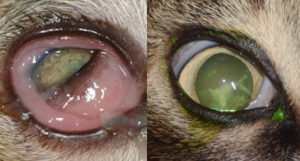ARTICLES
ONCE INFECTED, ALWAYS INFECTED: FELINE HERPESVIRUS
Published Wednesday, February 17, 2016

The spring and summer is kitten season! Veterinary ophthalmologists, therefore, see an upswing in the number of Feline Herpesvirus cases that require treatment.
Feline Herpesvirus is one of the most common causes for conjunctivitis and corneal ulceration in cats. The eye symptoms can be accompanied by upper respiratory disease as well. This virus is extremely widespread in the cat population with some studies showing that 90% of cats are exposed to herpes virus. The virus is not contagious to people or other species (ex: dogs). The virus is passed to other cats through sneezing, coughing, grooming, and generally being in close contact with an infected cat. Routine vaccination by your primary care veterinarian typically includes a herpes virus vaccine. This vaccine will minimize clinical signs of the disease but will not completely protect your cat from infection or future recurrence of herpes virus.
What does a Feline Herpesvirus infection look like?
Herpesvirus can cause a range of symptoms in the cat population. The mildest of infections lead to conjunctivitis (redness and swelling in the white part of the eye). Other symptoms include ocular and nasal discharge, sneezing, coughing, and corneal ulceration. Herpesvirus causes superficial ulcers (surface wounds) on the cornea (the clear windshield to the eye). Secondary bacterial infections, however, can lead to deeper ulcers and even corneal perforation. Studies show that 80% of cats initially infected with the virus will remain infected long-term. These cats are carriers for herpesvirus and will appear clinically normal after the initial infection. Much like cold sores in humans, the virus lives in the nerves of the face and can cause recurrence of symptoms throughout life. These recurrences typically occur during times of stress or illness. Not all cats will experience recurrence of clinical disease.
How do I know if my cat has Feline Herpesvirus?
Diagnosis of feline herpesvirus is largely based on ophthalmic examination and response to treatment.
Feline Herpesvirus is known for creating dendritic ulcers in the cornea that look like the branches on a tree.
When these ulcers are noted, veterinarians can make a firm diagnosis of feline herpesvirus.
Laboratory testing is available; however, tests tend to have many false positives and false negatives.
Is there treatment for Feline Herpesvirus?
Yes! We have targeted anti-viral medications that can shorten the course of disease. Anti-viral medications slow replication of the virus and allow your cat’s immune system to take care of the infection. The medication will not permanently clear herpesvirus from your cats system.
As viruses predispose animals to secondary bacterial infections, antibiotics are available and can be used in conjunction with anti-viral medications.
Studies have shown that during active herpesvirus infection, the tear film is negatively affected in cats. Thus, topical artificial tear preparations or other lubricants are used to make cats more comfortable during recovery.
Lysine, an amino acid supplement, has been shown to increase the time period between recurrences of herpesvirus symptoms.
As herpesvirus creates quite a bit of inflammation it may be tempting to treat cats with oral or topical steroids. This unfortunately will slow the cat’s immune response to the virus. Thus, the virus may cause more damage to the eye or the infection may last much longer than usual and become difficult to control. Topical and oral steroids are contraindicated in the treatment of feline herpesvirus.
 Located in the SAVS Facility
Located in the SAVS Facility
